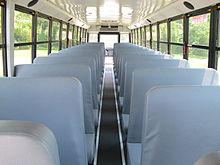School bus
| School bus | |
|---|---|

Front view of a typical North American school bus (IC CE)
|
|

Interior view of an empty school bus (Thomas Saf-T-Liner C2)
|
|
| Overview | |
| Manufacturer | List of school bus manufacturers |
| Body and chassis | |
| Doors | Front entry/exit door; rear/side emergency exit door(s) |
| Chassis | Cutaway van Cowled chassis Stripped chassis |
| Powertrain | |
| Engine | Various sizes of diesel (US, Europe) or gasoline (Canada) |
| Capacity | 10–90 passengers, depending on floor plan |
| Transmission |
|
| Dimensions | |
| Length | Up to 45 feet (13.7 m) |
| Width | Up to 102 inches (2,591 mm) |
| Curb weight | ≤10,000–36,000 pounds (4,536–16,329 kg) (GVWR) |
| Chronology | |
| Predecessor | Kid hacks |
A school bus is a type of bus used for student transport: carrying students to and from school, home, and school events. In North America, school buses are purpose-built vehicles distinguished from other types of buses by design characteristics mandated by federal and state regulations; most notably, the use of school bus yellow, allowed on no other vehicle on the road. In addition to their distinctive paint color, school buses are required to be fitted with warning lights and multiple safety devices.
Every year in the United States and Canada, school buses provide an estimated 10 billion student trips from home and school. Each school day in 2015, nearly 484,000 school buses transported 26.9 million children to and from school and school-related activities; over half of the United States K–12 student population is transported by school bus.
Outside North America, purpose-built vehicles for student transport are not as common. "School buses" can be a term in reference to buses in use for any bus dedicated to transporting students; the vehicles involved can be an older bus or coach retrofitted as a dedicated school bus or it can be a regular bus used for transporting students at the start and end of the school day, transporting adults during school hours and during the rest of the day.
In the second half of the 19th century, many rural areas of the United States and Canada were served by one-room schools. For those students who lived beyond practical walking distance from school, transportation was facilitated in the form of the kid hack; at the time, "hack" was a term referring to certain types of horse-drawn carriages. While some kid hacks were essentially repurposed farm wagons, others were purpose-built for transporting people instead of cargo, featuring bench-type seating. As these were horse-drawn vehicles, the entrance door was rear-mounted (in order to avoid startling the horses when loading or unloading passengers). Later, one of the longest-running school bus manufacturers, Wayne Works (later Wayne Corporation), started producing its first school wagons in Indiana in 1886.
Following the transition to "horseless carriages", kid hacks switched from horse-drawn wagons to motorized vehicles based on automotive chassis. In terms of design, little changed, as many early school bus bodies essentially remained wagons mounted to truck frames; the rear entry door and perimeter seating remained. Weather protection was nearly non-existent; if provided, it consisted of a tarpaulin stretched above the passenger area.
...
Wikipedia
